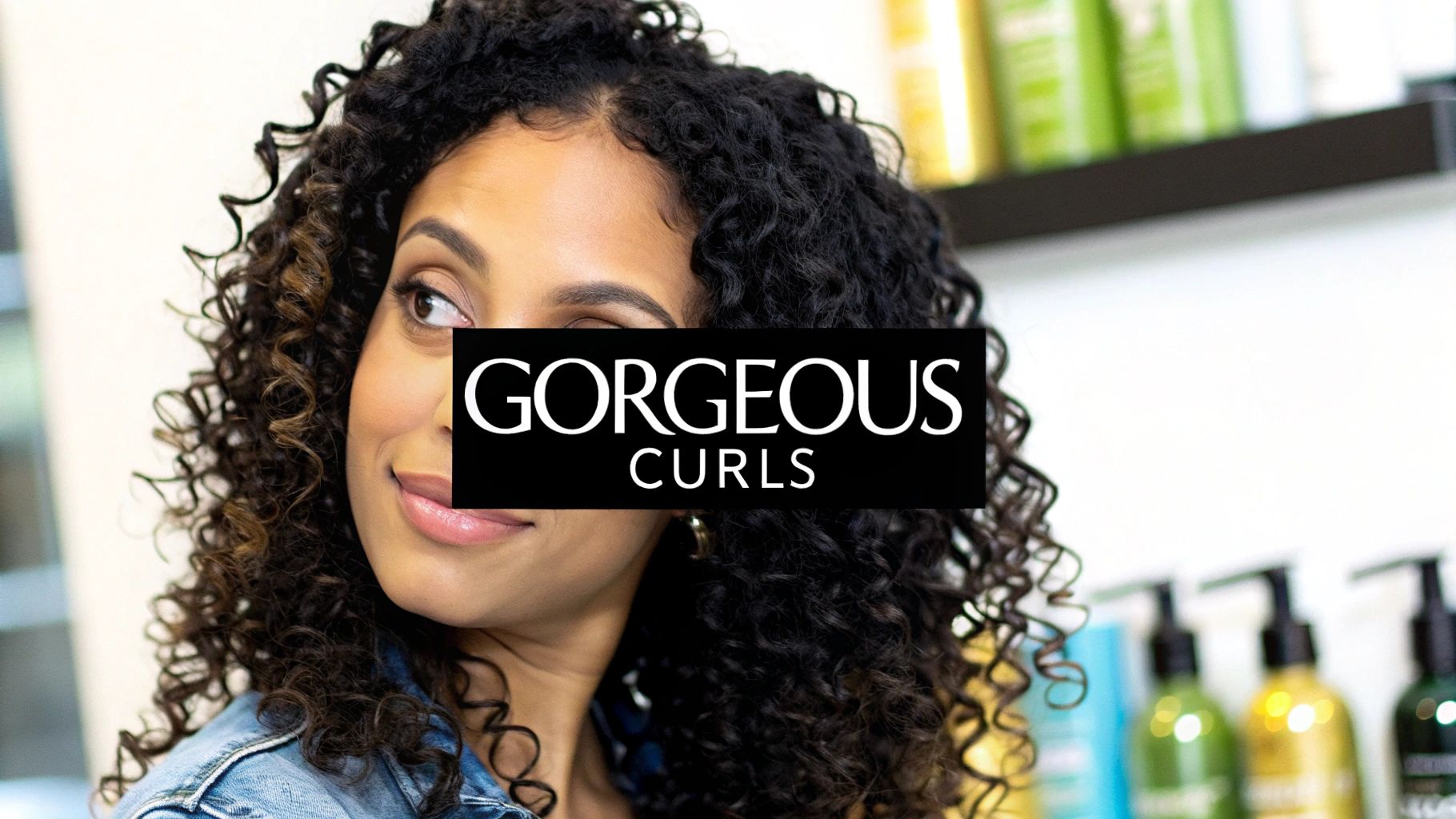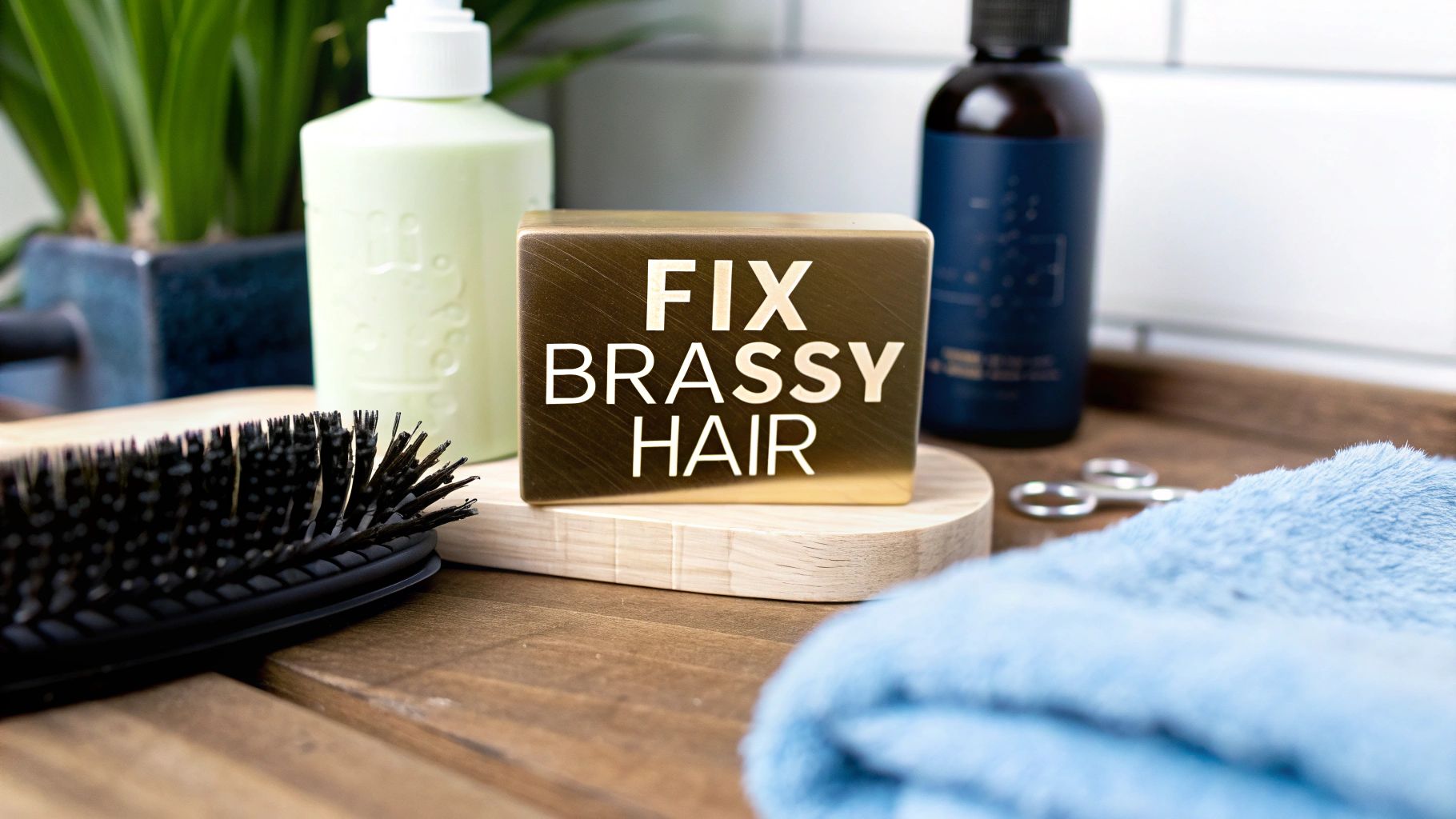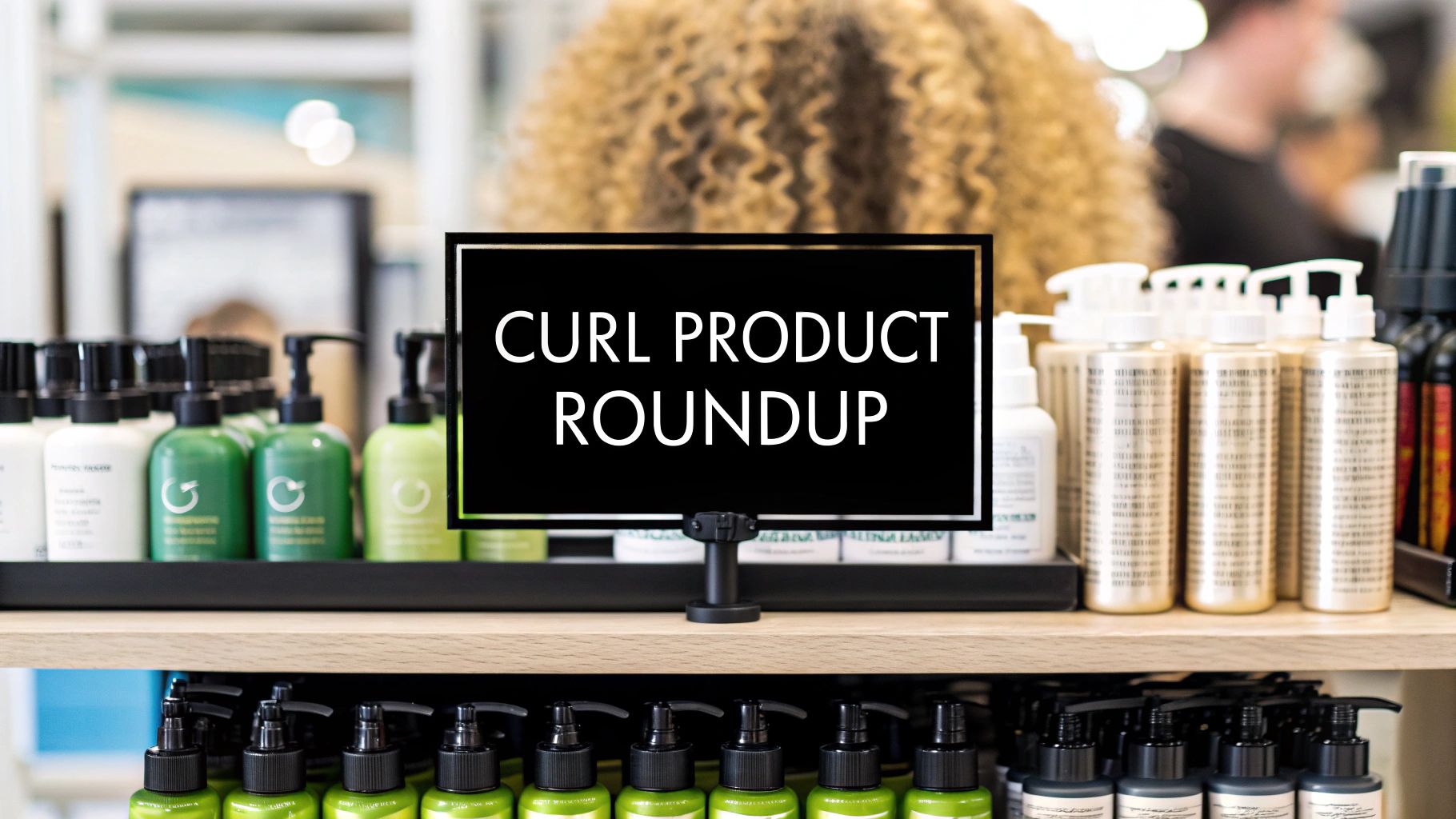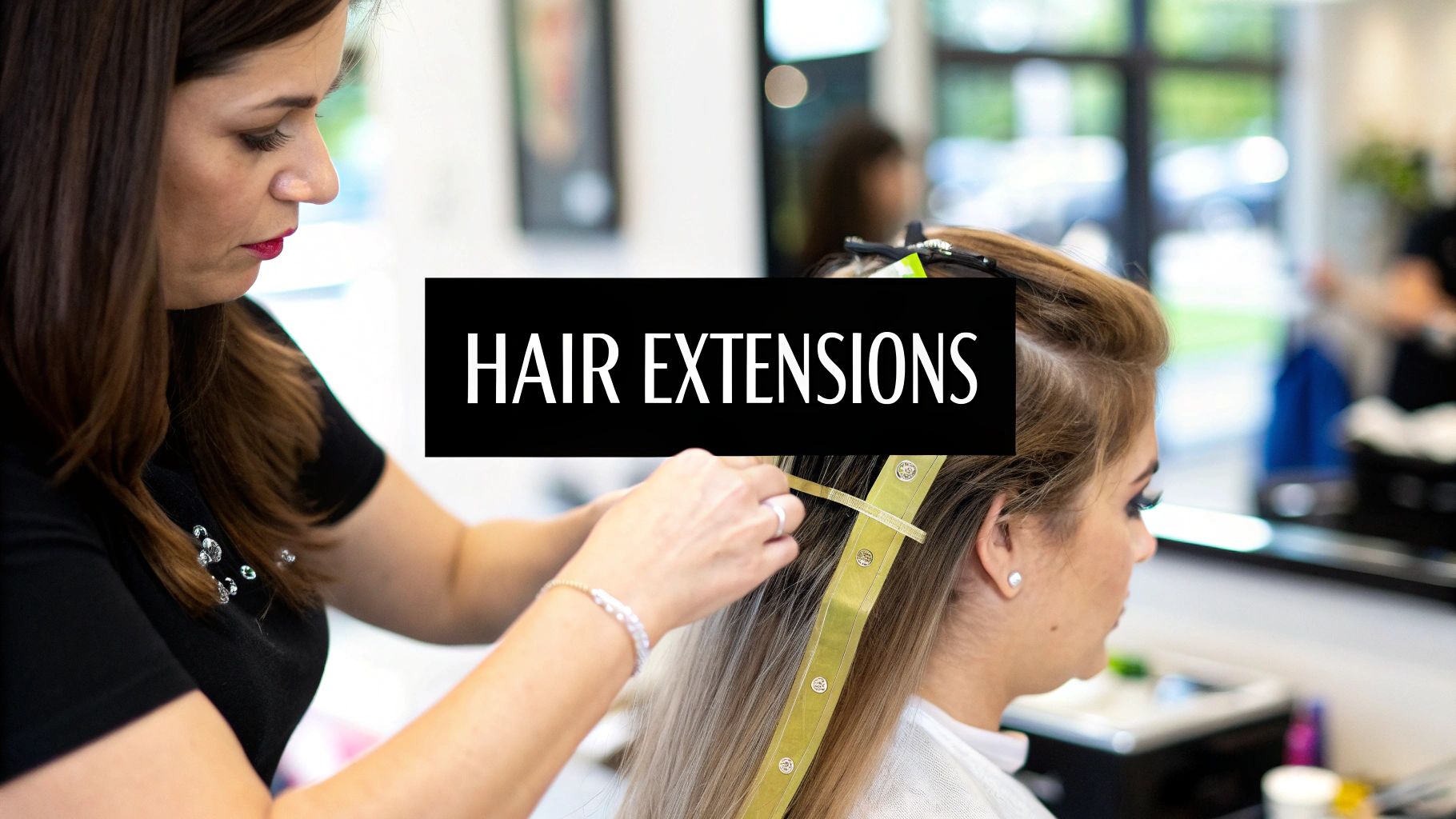If you want to maintain beautiful, healthy curls, the first thing to understand is that it all starts with moisture. A solid routine avoids harsh cleansers and the mistake of daily washing. The real magic happens when you use sulfate-free shampoos or co-washes, deep condition like you mean it, and apply your styling products to soaking wet hair. This simple sequence is what locks in definition and keeps frizz from taking over.
Thank you for reading this post, don't forget to subscribe!Building Your Foundational Wash Routine

The secret to consistently great curls isn't some complex, ten-step ritual. It really just comes down to what you do in the shower. Your foundational wash routine should be all about hydration, not stripping your hair squeaky clean.
Because of their shape, curls are naturally drier than straight hair. This makes them much more vulnerable to frizz and breakage if you don't handle them with a bit of extra care. That's exactly why the old "lather, rinse, repeat" advice with a standard shampoo every day is so damaging for curly textures. Traditional shampoos are often loaded with sulfates that strip away the natural oils your hair desperately needs to stay healthy and defined.
Choosing Your Cleanser
Instead of reaching for those harsh, bubbly shampoos, a curl-friendly routine focuses on gentle cleansing. For most people with curls, this means one of two approaches:
- Low-Poo Cleansers: Think of these as shampoos without the harsh stuff. They are sulfate-free and clean your scalp and hair without wringing out every last drop of moisture. They’re a fantastic starting point if you’re just making the switch from traditional products.
- Co-Washing: This just means washing your hair only with a cleansing conditioner. It's the most gentle option out there and works wonders for extremely dry or coily hair types that need to hold onto as much moisture as possible.
A great routine often uses both. You might find co-washing two or three times a week works perfectly, with a low-poo cleanser thrown in once a week to get rid of any product buildup. A clean scalp is non-negotiable, and you can dive deeper into this with our expert tips for curly hair scalp health.
Mastering Your Conditioning Technique
Believe it or not, how you apply conditioner is just as important as the product you choose. This is where the famous "squish to condish" method comes into play. It’s a game-changer.
After you've worked the conditioner through your hair, cup your ends in your palms and gently squeeze upwards toward the scalp. You’re essentially pushing the water and conditioner into the hair shaft. You’ll hear a distinct squishing sound, and that’s how you know your hair is actually absorbing all that good moisture. This technique is brilliant for encouraging your natural curl clumps to form right from the start.
Don't just let the conditioner sit on top of your hair—work it in. Proper application helps your curls absorb moisture, which is the cornerstone of how to maintain curly hair and fight frizz before it even starts.
As a final step, finish your shower with a quick rinse of cool or lukewarm water. This simple trick helps to seal the hair cuticle, locking in all the hydration you just worked so hard to add. A sealed cuticle means less frizz and a much shinier, more defined look once your hair is dry.
This whole movement towards gentle, hydrating hair care is making waves. In fact, the global hair care market is projected to expand from USD 96.9 billion in 2025 to USD 132.8 billion by 2035. A huge part of that growth is driven by people just like us demanding products with better, more nourishing ingredients.
The Golden Rule: Style on Soaking Wet Hair
If I could give just one piece of advice for getting defined, frizz-free curls, this would be it: always, always apply your styling products to soaking wet hair. I don't mean damp or towel-dried. I mean dripping wet, right out of the shower. This is the single most important moment in your routine.
When your hair is saturated with water, the cuticle is open and ready to absorb whatever you put on it. This allows your stylers to coat every single strand evenly, locking in that crucial moisture and setting your natural curl pattern before frizz even has a chance to form. Trying to apply products to partially dry hair just creates friction and leads to patchy, undefined results.
This foundational step is the key to a great wash day.

Think of each step in your routine as building on the last. You need a properly cleansed and hydrated base before you even think about reaching for your stylers.
Layering Products the Right Way
With your hair clean, conditioned, and still sopping wet, it's time to layer your products. There are a couple of popular methods out there, and the best one for you usually comes down to your hair's porosity—how well it absorbs and holds onto moisture.
- LOC Method (Leave-in, Oil, Cream): This is a go-to for high porosity hair, which tends to suck up moisture fast but lose it just as quickly. The leave-in provides a base of hydration, the oil immediately seals it in, and the cream adds another layer of moisture and definition.
- LCO Method (Leave-in, Cream, Oil): This order is typically better for low porosity hair, which often struggles to absorb moisture in the first place. By applying the cream after the leave-in, you give your hair a better chance to soak up that hydration before sealing the cuticle with oil.
Don't be afraid to experiment here. Your curls will let you know what they prefer.
It's All in the Application
How you put your products in your hair is just as important as what you're using. I see so many people rush this part and then wonder why their curls look inconsistent. The trick is to slow down, work in sections, and be deliberate.
Your goal isn't just to get product on your hair. It's to actively encourage your natural curl clumps to form. Taking your time with the right techniques is what separates good curls from great ones.
Here are a few trusted methods to try:
- Raking: Pretty straightforward—you just use your fingers like a rake to pull the product through from root to tip. It’s great for getting an even coating but can sometimes pull apart bigger curl clumps.
- Praying Hands: My personal favorite for fighting frizz. You sandwich a section of hair between your palms and glide them down the hair shaft. This smooths the product over your curls without disturbing their natural pattern.
- Scrunching: This is your best friend for encouraging curl formation and boosting volume. Just gently cup sections of your hair and scrunch upwards toward the scalp. It works wonders for wavies and looser curls.
And one last thing: don't be afraid of the "cast." If you're using a gel or mousse, your hair will likely dry with a stiff, crunchy feeling. That's a good thing! This cast is a protective shell that holds your curl definition and prevents frizz while your hair dries. Once your hair is 100% dry (and not a minute sooner), gently scrunch your curls to break the cast. You'll be left with soft, bouncy, and perfectly defined curls that actually last.
How to Choose the Right Products for Your Curls

Walking down the hair care aisle can feel completely overwhelming. You're faced with an endless wall of bottles, all promising perfect curls. But the real secret to finding products that work isn't about grabbing the trendiest new thing; it's about understanding what your hair actually needs.
This is where knowing your hair porosity changes everything. Porosity is simply your hair’s ability to soak up and hold onto moisture. Honestly, it often has a much bigger impact on your results than your specific curl pattern (like 3A or 4C) ever will. Figuring this out is a huge step toward mastering your curly hair routine.
What is Hair Porosity, Anyway?
Think of your hair's outer layer, the cuticle, like shingles on a roof. Porosity just describes how tightly those shingles are packed down.
-
Low Porosity: The shingles are sealed tight. This makes it tough for water and products to penetrate, which is why you might notice products just sitting on top of your hair, feeling heavy or greasy.
-
High Porosity: The shingles are raised and have gaps. This hair type drinks up moisture in a flash but loses it just as quickly. The result? Often, frizz and a constant feeling of dryness.
-
Medium Porosity: This is the sweet spot. The cuticle is just loose enough to let moisture in easily and hold onto it well.
Quick Tip: The Spray Bottle Test
To get a rough idea of your porosity, grab a spray bottle. On clean, product-free hair, mist a section with water. If the water beads up and sits there for a bit, you likely have low porosity. If it vanishes almost immediately, you're probably looking at high porosity.
Once you know your porosity, reading product labels becomes a whole lot easier. You can finally start building a routine with products that give your hair exactly what it’s asking for. If you want a head start, our guide on the top products at a curly hair salon is packed with great recommendations.
Matching Products to Your Porosity
Now for the fun part: picking products that will actually work for you, not against you.
If you have low porosity hair, you’ll want to stick with lightweight products that won’t cause buildup. Look for ingredients like glycerin or aloe that attract moisture, and style with foams, light lotions, or serums that won't weigh your curls down.
On the other hand, high porosity hair craves richer, heavier products. It loves ingredients like shea butter and olive oil that help seal in all that moisture it so easily absorbs. Styling creams and butters will become your new best friends, giving your hair the lasting hydration it needs to stay defined and frizz-free.
Picking the right product is simpler when you break it down by what you want to achieve.
Product Guide for Different Curl Needs
This table helps you choose the right styling product based on your hair's texture and desired outcome, simplifying the selection process.
| Hair Concern | Recommended Product Type | Key Benefit | Best For |
|---|---|---|---|
| Needs moisture & definition | Cream | Provides hydration and soft hold | Medium to coarse textures |
| Lacks volume & bounce | Mousse or Foam | Lightweight lift without crunch | Fine to medium textures |
| Fights frizz & needs strong hold | Gel | Seals the cuticle for maximum definition | All hair types, especially in humidity |
| Needs shine & to break a cast | Oil or Serum | Adds shine and softness | All hair types, used as a finisher |
Ultimately, finding the perfect product is a bit of trial and error, but understanding your porosity gives you a massive advantage.
The demand for products that cater to specific curl needs is growing fast. The global curly hair care market was valued at USD 3.1 billion in 2024 and is projected to hit USD 5.6 billion by 2033. This boom means more brands are finally creating thoughtful formulas for every hair type, making it easier than ever to find your perfect match. You can learn more about the curly hair care market's growth and see just how big the natural texture movement has become.
How to Dry and Protect Your Curls Day and Night
You've done all the hard work of cleansing, conditioning, and styling. Now comes the final, make-or-break moment: drying your hair. The wrong move here can unravel all your effort and summon a halo of frizz, but the right approach will lock in that gorgeous curl pattern for days.
A lot of us grew up grabbing the nearest bath towel, but that rough terrycloth is secretly a curl’s worst enemy. It roughs up the hair cuticle you just spent so much time smoothing down. Your first move should always be to gently squeeze out the excess water with just your hands. After that, you can move on to a much kinder drying method.
The Plopping Trick for Major Definition
If you want to encourage serious definition and slash your drying time, you need to learn how to plop. This isn't just a funny word; it's a game-changing technique that uses a soft cotton t-shirt or a microfiber towel to soak up extra water without causing a hint of frizz.
Here’s my simple breakdown of how to do it:
- Spread a t-shirt or microfiber towel out on your bed or a chair.
- Flip your hair forward, letting your curls pile up accordion-style in the center of the fabric.
- Grab the bottom edge of the shirt and pull it up over your hair to the base of your neck.
- Twist the sleeves and tie them securely at the back of your head.
You don't need to leave it on forever. Just 10-20 minutes is perfect. This gives the fabric enough time to absorb the heaviest water, letting your curls set in their natural shape without gravity pulling them down.
The Great Debate: To Diffuse or To Air-Dry?
Once your hair is plopped, you’ve got two paths forward. The best one for you really boils down to your hair type, the look you're going for, and, honestly, how much time you have.
Going Natural with Air-Drying
This is by far the gentlest option since there's zero heat involved. It’s my go-to recommendation for anyone with delicate strands or those who are serious about avoiding any potential for damage. The golden rule for air-drying? Hands off! The more you mess with your hair as it dries, the more you're inviting frizz to the party.
Getting a Boost with a Diffuser
A diffuser is that funny-looking bowl attachment for your blow dryer, and it’s a curly person’s best friend. It spreads out the airflow, so you're not blasting your curls with a harsh jet of heat. It's fantastic for pumping up the volume at your roots and getting you out the door faster.
For the best results, stick to low speed and low-to-medium heat. Gently cup sections of your hair in the diffuser bowl, hold it near your scalp for a minute or two to build volume, and then move on.
Your curl care routine doesn't end when your hair is dry. What you do overnight is just as crucial for keeping your style fresh and frizz-free for day two, three, and beyond.
Keeping Your Curls Intact While You Sleep
Tossing and turning on a standard cotton pillowcase is a recipe for disaster. All that friction can crush your curl pattern, leaving you with a tangled, frizzy mess in the morning. The solution is simple: switch to a smoother surface.
- Silk or Satin Pillowcase: Think of it as a slip-n-slide for your hair. These materials let your curls glide across the surface without snagging.
- Satin Bonnet or Scarf: For total protection, wrapping your hair in a bonnet or scarf keeps your curls safely contained and undisturbed all night long.
And don't forget the "pineapple" method! This is a lifesaver. Just gather all your hair into a super high, loose ponytail right on top of your head. This keeps you from squashing the majority of your curls while you sleep. Combine a pineapple with a silk pillowcase, and you've got the ultimate defense for gorgeous next-day hair.
Making Curls Last Between Wash Days
The real measure of a great curly hair routine isn't just how amazing your hair looks on wash day. It's how it holds up on day two, three, and even four. Nailing the art of the "refresh" is a total game-changer. It saves you a ton of time and lets you enjoy your style for longer.
The secret is reviving your curls, not starting from scratch. Most of the time, your hair doesn't need a full-on wash; it just needs a bit of moisture to wake up the products you already applied. A complicated refresh routine can backfire, leading to buildup that weighs your curls down. The goal here is a quick, targeted fix that breathes new life into your hair.
Simple Tricks for Next-Day Curls
One of the easiest methods I swear by is the water and leave-in spritz. Just grab a spray bottle and mix about 80% water with 20% of your favorite leave-in conditioner.
Lightly mist your hair, paying special attention to any frizzy spots or areas where your curl pattern has gone a little flat. After misting, gently scrunch your hair upwards to encourage the curls to spring back to life. If you have a few specific ringlets that have completely lost their way, you can just apply a tiny bit of extra product to your fingertips and smooth them back into shape. It's a targeted fix that literally takes less than five minutes.
Another fantastic option, especially if you have low-porosity hair that struggles to absorb moisture, is a hair steamer. The warm vapor gently lifts the hair's cuticle, which reactivates your wash day products without you having to add any more stylers. This technique gives you pure moisture and can revive even the most stubborn, slept-on curls.
The best refresh is almost always the simplest. You don't need to drench your hair. A light mist is usually all it takes to wake up your curls and redefine their shape. Overdoing it will just lead to limp, over-moisturized hair.
Adjusting Your Refresh for Your Climate
Where you live makes a huge difference in what your hair needs. If you're in a humid climate, for example, your refresh spray might need a touch of an anti-humectant gel to fight off frizz. But if you're in a dry climate, a richer, cream-based spray will be your best friend.
For a deeper dive into restoring definition, check out our full guide on how to bring some bounce to your curls.
This need for adaptable routines is really pushing the hair care industry forward. If you look at the curly hair care market, you see different growth patterns all over the world. North America is a leader because of its diverse population, while South America—especially Brazil—is seeing a huge boom rooted in a cultural appreciation for hair diversity.
The global curly hair care market is actually projected to hit around $7.2 billion by 2031. You can see more data on the growing curly hair product market to understand how these trends are shifting globally. Mastering your refresh is the perfect way to take advantage of all the incredible product innovations happening right now.
Your Top Curly Hair Questions, Answered

Even when you feel like you have a solid routine down, curly hair loves to keep us on our toes. Questions are going to pop up, and knowing how to troubleshoot the common culprits is what separates a good hair day from a frustrating one.
Think of this as your go-to guide for those moments when your curls just won't listen. From fighting surprise frizz to figuring out what your hair really needs, a little expert insight goes a long way.
How Can I Control Frizz in Humid Weather?
Ah, humidity. It can feel like the ultimate enemy of defined curls, but you can absolutely win this fight. The secret is creating a protective barrier around your hair before you walk out the door.
Your best defense starts with applying a styling product with serious hold—think a strong-hold gel or mousse—to soaking wet hair. Look for products with anti-humectant ingredients, which are specifically designed to repel moisture from the air.
But the most critical step? Make sure your hair is 100% dry before you leave the house. Even the slightest bit of dampness acts like a magnet for humidity, which is a fast track to frizz.
What Is the Difference Between Co-Washing and Clarifying?
These are two completely different ways of washing your hair, and both are essential for a healthy curl routine. It’s all about creating the right balance for your scalp and strands.
-
Co-washing is simply washing your hair with a cleansing conditioner. It's super gentle, helps preserve your natural oils, and is perfect for frequent washing, especially if your curls are prone to dryness.
-
Clarifying, on the other hand, is like hitting the reset button. It involves using a more powerful (but still sulfate-free) shampoo to get rid of all the gunk that builds up over time from products, hard water, or even your scalp’s own oils.
A good rhythm for many is to co-wash a few times a week and then clarify once a month. This keeps your hair hydrated day-to-day while ensuring buildup doesn't weigh your curls down.
Don't mistake buildup for dryness. If your hair feels limp, looks dull, or just won't hold its shape, it might not be begging for more moisture. It could be screaming for a deep clean to remove the product film that’s preventing moisture from getting in.
How Do I Know If My Hair Needs Protein or Moisture?
Learning to "read" your hair is a skill, and this is probably its most common request. The easiest way to get an answer is with a quick "stretch test." Just take a single, clean strand of wet hair and gently pull it.
If the strand stretches a lot before it snaps, almost feeling a bit gummy or mushy, it’s over-moisturized. Your hair is begging for protein to rebuild its structure and strength.
But if the strand barely stretches at all and snaps right away, feeling rough and brittle, it's thirsty. That’s a clear sign it needs a deep dose of moisture. Getting this protein-moisture balance right is the foundation of strong, bouncy, and healthy curls.
Ready to give your curls the expert care they deserve? The stylists at Hairicc specialize in creating personalized routines and styles that celebrate your natural texture. Book your appointment with a curly hair expert today!



